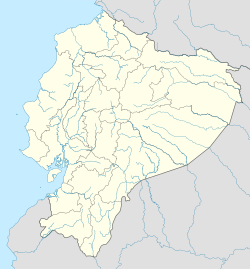Saraguro people
Saraguro | |
|---|---|
Town and ethnic group | |
| Coordinates: 3°37′20″S 79°14′23″W / 3.62222°S 79.23972°W | |
| Elevation | 2,518 m (8,261 ft) |
| Time zone | UTC- |
| Climate | Cfb |
The Saraguro people are an ethnic group, most of whom live in Saraguro Canton in the Loja Province of Ecuador. Although most now speak Spanish, Kichwa, a Quechua dialect, is still spoken. The Saraguro have retained much of their land, customs and traditional dress. They number about 30,000.
The Saraguro may be the descendants of people re-settled from distant regions in the Inca Empire in the 15th and early 16th century.
Origins

In the 1460s the Inca empire conquered the Saraguro area. The pre-Inca people may have been the barely-known Palta or the Cañari. The ancestors of the modern-day Saraguro people, according to oral traditions, were moved to Saraguro by the Incas from other areas, possibly the Colla or other people from the Lake Titicaca and Cuzco regions. The Incas had a policy of forcibly moving people from one region of the empire to another, thereby diversifying the population and dispersing possible opposition to their rule. The resettlement policy was called mitma. The numbers resettled were large, estimated to be up to 80 percent of the population of some provinces.[1]
One Spanish document says that the ancestors of present-day Saraguros were elite soldiers in the Inca army. This statement is bolstered by the fact that the Saraguros live along the Inca road that stretched from Cuzco to Tumebamba (the northern capital of the Incas), and onward to Quito and thus occupied an important link for Inca communications and control of the empire. The town of Saraguro, however, seems to have been founded by the Spanish rather than the Incas although a number of Inca ruins are in the nearby area.[2]
Whatever the facts about their origins. Saraguro in the 20th century celebrate their Inca heritage. Oral traditions ascribes the black clothing typical of the Saraguro as a sign of mourning for the death of the Inca Emperor Atahualpa. Schools have been named after Inca emperors, Inca customs recreated, Inca architecture copied, and efforts made to preserve the Kichwa language.[3]
The Saraguros have retained control over their lands more successfully than many of the Andean subjects of the Spanish Empire and the independent country of Ecuador. Part of this may be due to their initial hostility to the Spanish and the indigenous people who collaborated with them. More importantly, however, the Saraguros were required by the Spanish to maintain an important tambo (inn or way-station) along a major communication route. They successfully argued that the operation and maintenance of the tambo required that they retain their land and its resources. They continued to manage the tambo until the 1940s when a motor road reached the area.[4]
Contemporary Saraguros
Most of the Saraguros live at intermediate elevations in the Andes between 1,800 metres (5,900 ft) and 2,800 metres (9,200 ft). Traditionally they are farmers and livestock herders. A shortage of land in their homeland has led many to migrate eastward into the Zamora-Chinchipe Province of Ecuador.[5]
References
- ^ Ogburn, Dennis J. (nd), Incas Past and Present: Archaeology and the Indigenous Saraguros of Southern Ecuador", Stanford Journal of Archaeology, https://web.stanford.edu/dept/archaeology/journal/07Ogburn.pdf, accessed 24 Mar 2017
- ^ Belote, Jim and Belote, Linda (2004), "The Incas in the Saraguro Region", http://www.saraguro.org/archinka.htm, accessed 24 Mar 2017; Ogburn (nd), pp. 141-143
- ^ Ogburn (nd), pp. 142-149
- ^ Belote, Jim and Belote, Linda S. (1999), "The Saraguros, 1962-1997: A Very Brief Overview", http://www.saraguro.org/overview.htm, accessed 24 Mar 2017
- ^ Belote and Belote (1999)

